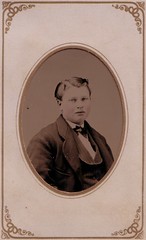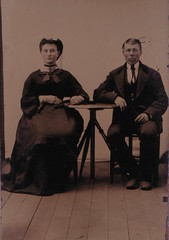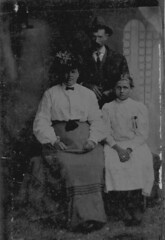Difference between revisions of "Ferrotype"
m (now it's OK) |
|||
| Line 3: | Line 3: | ||
||[http://www.flickr.com/photos/89864432@N00/3288940816/in/pool-camerapedia/ http://farm4.static.flickr.com/3253/3288940816_be0560d975_m.jpg] | ||[http://www.flickr.com/photos/89864432@N00/3288940816/in/pool-camerapedia/ http://farm4.static.flickr.com/3253/3288940816_be0560d975_m.jpg] | ||
||[http://www.flickr.com/photos/89864432@N00/3222977420/in/pool-camerapedia http://farm4.static.flickr.com/3474/3222977420_860f038975_m.jpg] | ||[http://www.flickr.com/photos/89864432@N00/3222977420/in/pool-camerapedia http://farm4.static.flickr.com/3474/3222977420_860f038975_m.jpg] | ||
| − | |||
| − | |||
|- | |- | ||
||young American | ||young American | ||
Revision as of 14:10, 23 January 2011

|

|

| ||
| young American | American couple | American family | two gentlemen | two young ladies |
Ferrotypes (also known {in the USA} as Tintypes) are photographs made onto black-enamelled iron plates by the wet-collodion process. The black background made the transparent areas of the negative image appear black, and the dark, silvered areas were whitened using mercuric bichloride, and so appear light - in the same way as glass Ambrotypes.
French photographer Adolphe A Martin was the first to use this process, in 1853. A dry ferrotype processes later replaced the wet-plate system. As the process could be carried out inside the camera and needed no drying time, dry ferrotypes were popular with "while-you-wait" beach and street photographers[1]. Some cameras were advertised specifically for this purpose, such as the Mandel-ette.
Since the image must be viewed from the silvered side of (non-transparent!) plate, the image is left-right reversed (mirror-imaged) - a fault shared with most Daguerreotypes.
The process was used in the US until the early 1940s.
- ↑ Focal Encyclopedia of Photography, Focal Press, 1976 edition, p.588